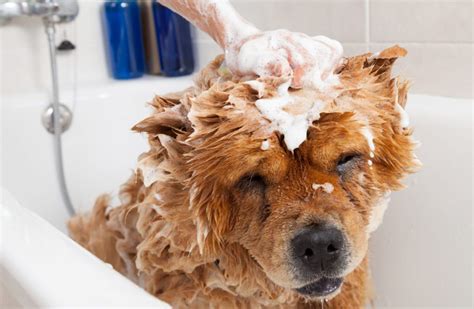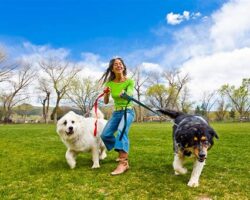Learn how to keep your pet looking and feeling their best with tips on grooming, nutrition, and health. Find out more now!
Regular Brushing
Regular brushing is essential for maintaining a healthy coat for your dog. Not only does it help to remove dirt, debris, and tangles, but it also stimulates the skin and promotes natural oil production. This is especially important for breeds with long or thick fur as they are more prone to matting and tangles. By brushing your dog on a regular basis, you can prevent these issues and keep their coat looking and feeling great.
When choosing the right brush, it’s important to consider your dog’s specific coat type. Different brushes are designed for different lengths and textures of fur, so it’s important to select the appropriate one for your pet. For example, a slicker brush is great for removing tangles in long, thick fur, while a bristle brush works well for short-haired breeds. Regular brushing not only helps with grooming, but it also provides an opportunity to check for any abnormalities or signs of skin issues.
Regular brushing should be a bonding experience for you and your dog. It’s a chance for you to spend quality time together, while also ensuring that your pet’s coat is in tip-top condition. When done properly and consistently, brushing can help prevent shedding, distribute natural oils, and keep your dog looking their best.
Choosing the Right Shampoo
Choosing the Right Shampoo
Dogs, much like humans, require regular grooming to maintain a healthy coat. One important aspect of grooming is choosing the right shampoo for your furry friend. Using the right shampoo can help keep your dog’s coat clean and healthy, while using the wrong one can lead to skin irritation and other health issues.
When selecting a shampoo for your dog, it’s important to consider their specific needs. For example, if your dog has sensitive skin, you’ll want to choose a shampoo that is designed for sensitive skin. Similarly, if your dog has a specific skin condition, such as allergies or dermatitis, you’ll want to look for a shampoo that is formulated to address that condition.
Besides considering your dog’s skin type, you’ll also want to look for shampoos that are made with natural ingredients and free of harsh chemicals. These can help prevent dryness and irritation, while nourishing your dog’s skin and coat. Additionally, you may want to consider shampoos that are formulated to target specific issues, such as shedding or odor control.
Proper Bathing Techniques
Proper bathing techniques are essential for maintaining a healthy coat for your furry friend. Before giving your dog a bath, it’s important to brush them thoroughly to remove any tangles or mats. Use a dog-specific shampoo to prevent skin irritation and maintain the pH balance of their skin. When bathing your dog, make sure to use lukewarm water and avoid getting water in their ears or eyes, as this can cause discomfort. Take your time to lather the shampoo and thoroughly rinse it out to prevent any residue from causing skin irritation.
After the bath, make sure to thoroughly dry your dog with a clean towel or a low-heat setting on a blow dryer. This is especially important for dogs with longer coats, as trapped moisture can lead to skin problems and matting. Additionally, it’s important to establish a regular bathing schedule based on your dog’s coat type and activity level. Over-bathing can strip the natural oils from your dog’s skin, leading to dryness and irritation.
By following these proper bathing techniques, you can help maintain a healthy coat for your dog and prevent any skin or coat issues. Remember to always use dog-specific products and consult with your veterinarian if you have any concerns about your dog’s skin or coat health.
Trimming and Clipping
Dogs require regular grooming to maintain a healthy coat and overall well-being. Trimming and clipping are essential parts of the grooming routine, helping to keep the dog’s coat tidy and free from tangles. It is important to use the proper grooming tools to ensure a safe and effective clipping experience for your furry friend.
When it comes to trimming and clipping your dog’s coat, it is important to choose the right type of scissors or clippers for the job. The tools should be sharp and well-maintained to avoid causing any discomfort or harm to the dog. Additionally, it is essential to use caution and patience while clipping to ensure that you do not accidentally cut the dog’s skin.
Regular trimming and clipping also help to prevent matting and tangles in the dog’s coat, which can lead to discomfort and skin irritation. By keeping the coat tidy and free from tangles, you can help your dog maintain a healthy and shiny coat. It is important to establish a regular grooming routine that includes trimming and clipping to keep your dog looking and feeling their best.
Balanced Diet and Nutrition
Top 10 Dog Grooming Tips for a Healthy Coat
Diet plays a huge role in the overall health and appearance of your dog’s coat. Providing your dog with a balanced and nutritious diet is essential for maintaining a healthy coat. Make sure to feed your dog high-quality dog food that contains essential nutrients such as protein, omega-3 fatty acids, vitamins, and minerals. These nutrients are vital for the growth and maintenance of a shiny and healthy coat.
Additionally, supplementing your dog’s diet with fresh fruits and vegetables can provide additional vitamins and minerals that are beneficial for your dog’s coat. Avoid feeding your dog table scraps and foods that are high in unhealthy fats and sugars, as these can negatively impact your dog’s coat and overall health.
Proper hydration is also important for maintaining a healthy coat. Make sure that your dog has access to clean and fresh water at all times to keep their skin and coat hydrated.
Avoiding Over-bathing
One of the key aspects of maintaining a healthy coat for your dog is to know when to avoid over-bathing. While regular bathing is important for your dog’s hygiene, over-bathing can strip their coat of essential oils and cause skin irritation. It’s important to strike a balance and understand the signs that indicate your dog may be over-bathed.
First and foremost, it’s crucial to understand your dog’s breed and coat type. Some breeds and coat types may require more frequent baths, while others may only need occasional bathing. Consulting with a professional groomer or veterinarian can help you determine the appropriate bathing schedule for your dog based on their specific needs.
In addition to understanding your dog’s breed and coat type, it’s important to observe their skin and coat condition. If you notice dry, flaky skin or a dull, brittle coat, it may be a sign that your dog is being over-bathed. In such cases, it’s best to reduce the frequency of baths and focus on using gentle, moisturizing shampoos to prevent further damage to their coat and skin.
Controlling Shedding
Controlling Shedding
Dogs are known to shed hair as part of their natural process of replacing old or damaged fur. While some shedding is normal, excessive shedding can be a sign of an underlying health issue or poor grooming habits. Here are some tips to help you control your dog’s shedding and keep their coat healthy:
First, make sure to brush your dog regularly with the right grooming tools. This helps to remove loose hair and prevent it from ending up all over your furniture and floors. Additionally, choosing the right shampoo can help to keep your dog’s skin and coat healthy, reducing shedding in the long run.
Another important step in controlling shedding is to ensure your dog is receiving a balanced diet and proper nutrition. A healthy diet leads to healthier fur and less shedding. Lastly, regular vet check-ups can help to identify any underlying health issues that may be causing excessive shedding.
Regular Vet Check-ups
Regular Vet Check-ups
Regular veterinarian check-ups are an essential part of maintaining your dog’s overall health and well-being. Just like humans, dogs require regular medical check-ups to ensure that they are in good health and to catch any potential health issues early on. It is recommended to schedule a veterinary visit at least once a year, although some dogs may require more frequent visits depending on their age, breed, and overall health.
During a veterinary check-up, your vet will conduct a thorough physical examination of your dog, checking for any signs of illness or injury. They will also administer any necessary vaccinations and may run additional tests such as blood work or urine analysis to ensure that your dog is in good health. Regular vet check-ups can help to identify and address any health issues before they become more serious, ultimately saving you time, money, and stress.
In addition to the physical examination and vaccinations, a veterinarian check-up is also an opportunity for you to discuss any concerns or questions you may have about your dog’s health. Your vet can provide guidance on nutrition, exercise, and preventative care to ensure that your dog stays healthy and happy. By prioritizing regular veterinary care, you can help to ensure that your dog leads a long, healthy, and fulfilling life.
Preventing Matting and Tangles
Preventing matting and tangles in your dog’s coat is essential for maintaining a healthy and attractive appearance. One of the most important steps in preventing matting and tangles is regular brushing. Brushing your dog’s coat daily helps to remove loose hair and prevent it from becoming tangled with the surrounding fur. It also helps to distribute natural oils throughout the coat, keeping it shiny and healthy.
Another key factor in preventing matting and tangles is choosing the right shampoo for your dog. Using a high-quality, moisturizing shampoo can help to keep your dog’s coat soft and manageable, reducing the likelihood of tangles forming. Additionally, proper bathing techniques, such as thoroughly rinsing out all shampoo and conditioner, can help to prevent residue from building up in the coat and causing tangles.
Finally, using safe and effective grooming tools is crucial in preventing matting and tangles. Tools such as slicker brushes and dematting combs can help to gently remove tangles and prevent them from becoming larger knots. By taking these preventative measures, you can keep your dog’s coat looking and feeling its best.
Using Safe and Effective Grooming Tools
Using Safe and Effective Grooming Tools
When it comes to grooming your furry friend, it’s essential to use safe and effective grooming tools to ensure their coat stays healthy and shiny. One of the most important tools you can have is a high-quality brush that is gentle on your dog’s skin. Look for brushes with soft bristles that won’t scratch or irritate their skin, and be sure to brush gently to avoid pulling on any tangles or mats.
Another essential grooming tool is a good pair of nail clippers. Keeping your dog’s nails trimmed is important for their overall health, as long nails can cause discomfort or even affect their gait. Be sure to use dog-specific nail clippers and to trim carefully, avoiding the quick (the sensitive part of the nail) to prevent bleeding and pain.
Lastly, invest in a safe and effective shampoo and conditioner for your dog’s coat. Look for products specifically designed for dogs, as human shampoos can be too harsh for their skin. Choose a gentle, all-natural shampoo that will clean their coat without stripping its natural oils, and follow up with a moisturizing conditioner to keep their fur soft and shiny.
Frequently Asked Questions
What are the benefits of regular grooming for a dog’s coat?
Regular grooming helps to remove dead hair, distribute natural oils, prevent matting, and check for any skin issues or parasites.
How often should I brush my dog’s coat?
The frequency of brushing depends on the dog’s breed and coat type, but generally, it’s recommended to brush your dog at least a few times a week.
Should I bathe my dog regularly for a healthy coat?
Bathing your dog every 4-6 weeks with a mild dog shampoo can help keep the coat clean and healthy, but over-bathing can strip the natural oils from the skin.
What type of brush is best for my dog’s coat?
The type of brush depends on your dog’s coat type – slicker brushes for long-haired breeds, bristle brushes for short-haired breeds, and undercoat rakes for double-coated breeds.
How can I prevent tangles and matting in my dog’s coat?
Regular brushing, especially in areas prone to tangling such as behind the ears and under the legs, can help prevent tangles and matting in your dog’s coat.
Are there any dietary tips for a healthy dog coat?
A balanced diet with essential fatty acids, such as omega-3 and omega-6, can help improve the health and appearance of your dog’s coat.
What are some signs of a healthy coat in a dog?
A healthy dog coat should be shiny, smooth, and free from excessive shedding, dandruff, or dry patches. It should also not have a foul odor.





